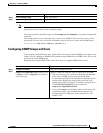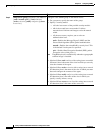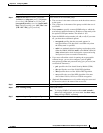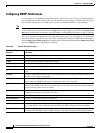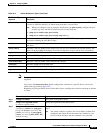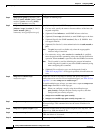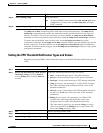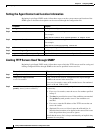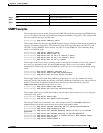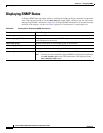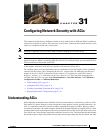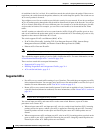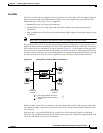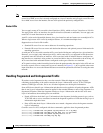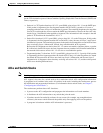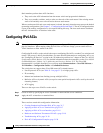
30-17
Catalyst 2960 and 2960-S Switch Software Configuration Guide
OL-8603-09
Chapter 30 Configuring SNMP
Configuring SNMP
SNMP Examples
This example shows how to enable all versions of SNMP. The configuration permits any SNMP manager
to access all objects with read-only permissions using the community string public. This configuration
does not cause the switch to send any traps.
Switch(config)# snmp-server community public
This example shows how to permit any SNMP manager to access all objects with read-only permission
using the community string public. The switch also sends VTP traps to the hosts 192.180.1.111 and
192.180.1.33 using SNMPv1 and to the host 192.180.1.27 using SNMPv2C. The community string
public is sent with the traps.
Switch(config)# snmp-server community public
Switch(config)# snmp-server enable traps vtp
Switch(config)# snmp-server host 192.180.1.27 version 2c public
Switch(config)# snmp-server host 192.180.1.111 version 1 public
Switch(config)# snmp-server host 192.180.1.33 public
This example shows how to allow read-only access for all objects to members of access list 4 that use
the comaccess community string. No other SNMP managers have access to any objects. SNMP
Authentication Failure traps are sent by SNMPv2C to the host cisco.com using the community string
public.
Switch(config)# snmp-server community comaccess ro 4
Switch(config)# snmp-server enable traps snmp authentication
Switch(config)# snmp-server host cisco.com version 2c public
This example shows how to send Entity MIB traps to the host cisco.com. The community string is
restricted. The first line enables the switch to send Entity MIB traps in addition to any traps previously
enabled. The second line specifies the destination of these traps and overwrites any previous
snmp-server host commands for the host cisco.com.
Switch(config)# snmp-server enable traps entity
Switch(config)# snmp-server host cisco.com restricted entity
This example shows how to enable the switch to send all traps to the host myhost.cisco.com using the
community string public:
Switch(config)# snmp-server enable traps
Switch(config)# snmp-server host myhost.cisco.com public
This example shows how to associate a user with a remote host and to send auth (authNoPriv)
authentication-level informs when the user enters global configuration mode:
Switch(config)# snmp-server engineID remote 192.180.1.27 00000063000100a1c0b4011b
Switch(config)# snmp-server group authgroup v3 auth
Switch(config)# snmp-server user authuser authgroup remote 192.180.1.27 v3 auth md5
mypassword
Switch(config)# snmp-server user authuser authgroup v3 auth md5 mypassword
Switch(config)# snmp-server host 192.180.1.27 informs version 3 auth authuser config
Switch(config)# snmp-server enable traps
Switch(config)# snmp-server inform retries 0
Step 4
end Return to privileged EXEC mode.
Step 5
show running-config Verify your entries.
Step 6
copy running-config startup-config (Optional) Save your entries in the configuration file.
Command Purpose



